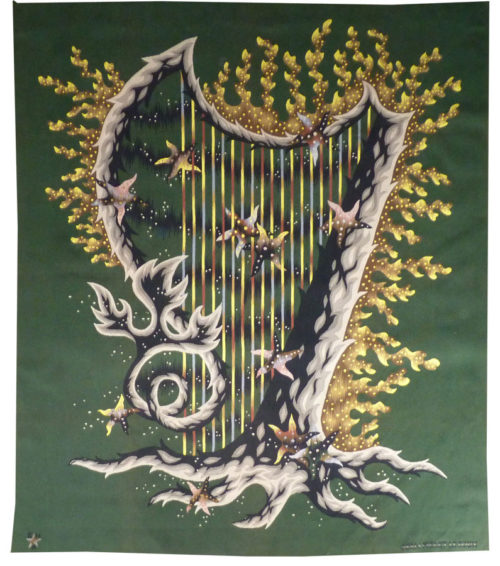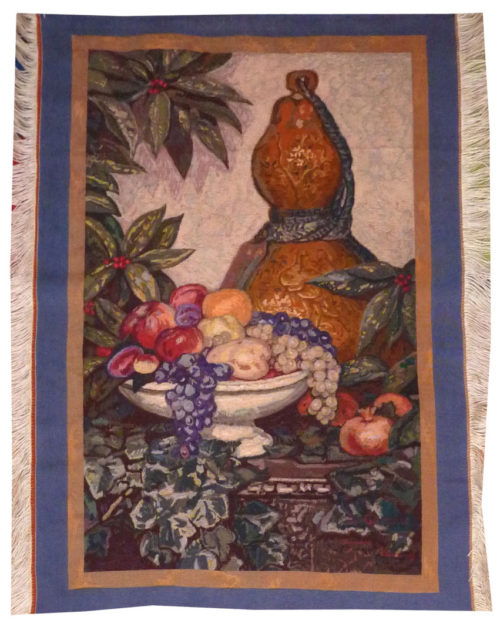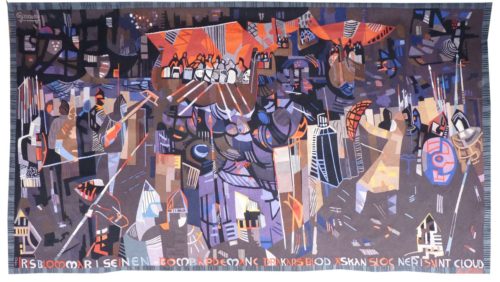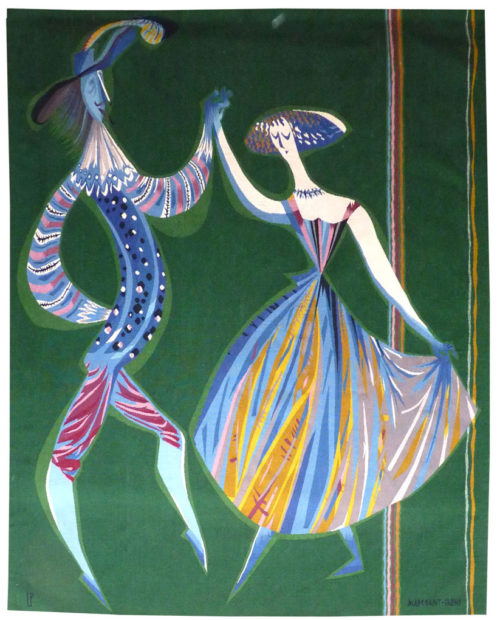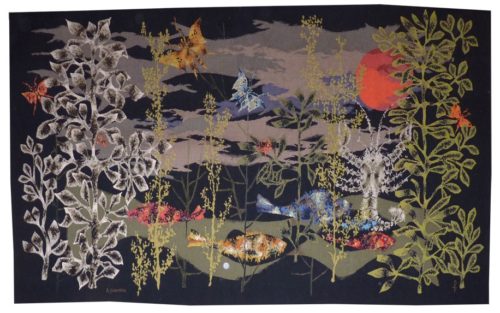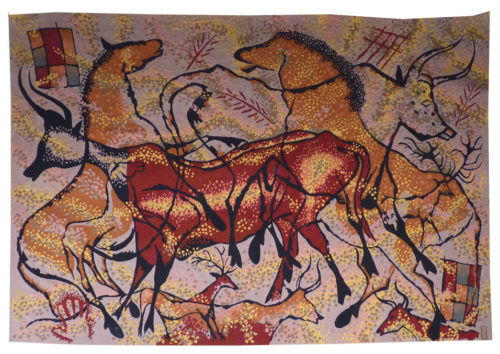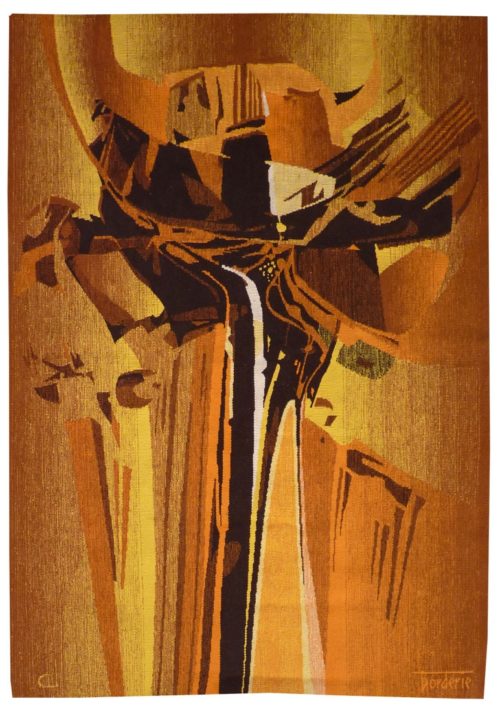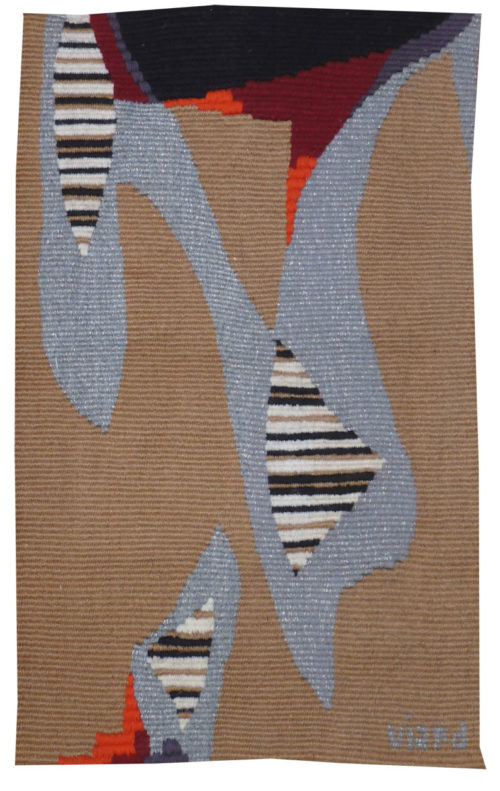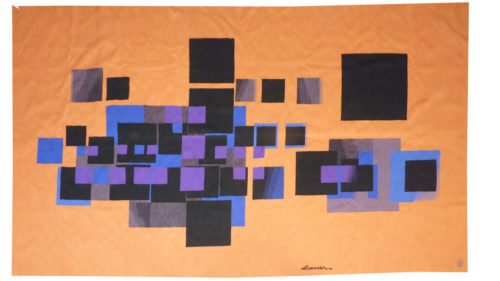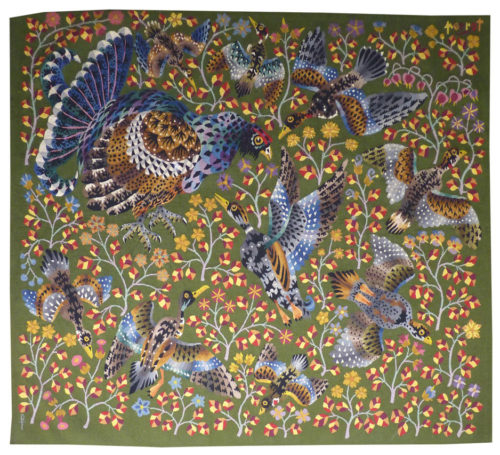-
Nature morte (still life)
Gobelins tapestry woven by G. Bonnevialle. Complete with label. 1930-1931 (after a 1921 painting). An establishment artist of classical training, Migonney spent many long years in Algeria, which would furnish the subject of much of his work. He gave several cartoons to the Ecole Nationale d’Art Décoratif in Aubusson (along with Véra, Valtat...), whose exhibition stand at the Exposition Internationale des Arts Décoratifs in 1925 included a panel bearing one of his tapestries. This piece is a detail, woven after the artist’s death, taken from a spectacular work (137x205cm) dating from 1921 which hangs in the Musée de Brou in Bourg en Bresse, “Still life with fruit”. It reveals all the weaving detail and nuances which constituted the art of the Gobelin weavers when reproducing a painting, techniques whose use Lurcat would soon make a point of opposing. Bibliography : Exhibition Cat. Tapisseries 1925, Aubusson, Cité de la Tapisserie, 2012 -
Normands sur la Seine (Norsemen on the Seine)
Tapestry woven at Aubusson by the Pinton workshop. Signed certificate of origin n° 1. 1961. Lars Gynning is one of the numerous artists of various origins whose work would be woven in Aubusson during the years from the 50’s to the 70’s, at a period when tapestry imposed itself as an artistic medium. From a thematic point of view, this cartoon can be seen as a referrence, across the centuries, to Franco-Scandinavian relations seen through the prism of Viking incursions up the Seine estuary : an inevitable throw-back to the Bayeux tapestry. However, rather than a historic or diplomatic statement by Gynning, the cartoon in fact illustrates a saga by Evart Taube, the 20th century Swedish national poet (an extract from the text is woven at the bottom of the tapestry) ; added to the subject itself, the textile rendition of an epic saga is a gesture in the direction of the great mediaeval tapestry tradition, which was an inevitable model for many painter-cartoonists of the period. The aesthetic, which is resolutely contemporary and influenced by cubism, revitalises an ancient subject. -
Les comédiens (The actors)
Aubusson tapestry woven in the Legoueix workshop. N°4/6. 1959. Lurçat approached Saint-Saëns, originally a painter of murals, in 1940. And during the war the latter produced the first of his allegorical masterpieces, tapestries reflecting indignation, combat, resistance : “les Vierges folles (the foolish virgins), “Thésée et le Minotaure” (Theseus and the Minotaur). At the end of the war, as a natural development he joined up with Lurçat, whose convictions he shared (concerning a simplified palette, outlined cartoons with colours indicated by pre-ordained numbers, and the specific nature of tapestry design...) at the A.P.C.T. (Association des Peintres-cartonniers de Tapisserie). His universe, where the human figure, stretched, elongated, ooccupies an important place (particularly when compared to his companions Lurçat or Picart le Doux), pivots around traditional themes : woman, the Commedia dell’arte, Greek mythology... refined by the brilliance of the colours and the simplification of the layout. His work would evolve later, in the 1960’s, towards cartoons of a more lyrical design, almost abstract where elemental and cosmic forces would dominate. Themes of music, drama and more specifically the Commedia dell’Arte (« la Comédie Italienne », a cartoon dating from 1947) are omnipresent in Saint-Saëns’s production : here he presents the figures of Lelio and Isabelle, strikingly drawn, slightly humorous figures, presented here in their traditional costumes. Bibliography : Exhibition catalogue Saint-Saëns, galerie La Demeure, 1970 Exhibition catalogue Saint-Saëns, the tapestries, Aubusson, Musée départemental de la Tapisserie, 1987 Exhibition catalogue Marc Saint-Saëns, tapestries, 1935-1979, Angers, Musée Jean Lurçat et de la Tapisserie Contemporaine 1997-1998 -
Poissons de la lune (Moon fish)
Aubusson tapestry woven by the Pinton workshop. Complete with certificate of origin. Circa 1960. Fumeron designed his first cartoons (he would ultimately make over 500) in the 1940’s, in collaboration with the Pinton workshop, he was then commissioned on numerous occasions by the state before participating in the decoration of the ocean liner “France”. His work was figurative to begin with and influenced by Lurçat, then turned towards abstraction, before coming back to a style characterised by colourful figurative and realistic depictions from the 1980’s onwards. Beneath the red moon, fish, butterflies, a lobster all frolic in a dream-like composition typical of the artist : numerous examples of these motifs can be found for instance in “Avant l’homme” Before man, woven by the Gobelins (cf Exhibition Catalogue “le Mobilier National et les Manufactures Nationales des Gobelins et de Beauvais sous la IVe République”, Beauvais 1997) -
Hommage à l'abbé Breuil (a tribute to Father Breuil)
Aubusson tapestry woven by the Pinton workshop. Complete with certificate of origin. Circa 1955. Perrot began his career as a cartoon designer at the end of the war, making almost 500 cartoons including numerous commissions from the state, most of which were woven at Aubusson. His style which is particularly rich and decorative is eminently recognisable : a crowd of butterflies or birds, most often, stands out against a background of vegetation, reminiscent of the millefleurs tapestries (which would also inspire Dom Robert). Uncharacteristic cartoon whose inspiration lies in the cave paintings at Lascaux ; here it can be said that never has a tapestry merited quite so well the term « wall art ». Perrot’s input is, in the end, relatively modest : the use of saturated colours (particularly the mauve-pink background), the overlapping of the motifs (which are more spaced out in the cave itself), superficial laid over blotching,... If Perrot is an habitué of hommage-cartoons (Pergaud, Redouté, Audubon,...) this particular example is interesting because of the well-established proximity between the artist and the dedicatee, “the Pope of Prehistory”: here the hommage owes nothing to the artificiality of an official commission. Bibliography : Tapisseries, dessins, peintures, gravures de René Perrot, Dessein et Tolra, 1982 -
Fleur de roc (rock flower)
Aubusson tapestry woven in the Legoueix workshop. n°2/4. Circa 1970. Originally a sculptor exploiting very diverse materials (steel, concrete, clay…), Borderie came to tapestry with immense enthusiasm in the 1950’s with the weaving of his first cartoon in 1957. Receiving encouragement from Denise Majorel, he was awarded the Grand Prix National de la Tapisserie in 1962. In 1974 he was appointed as director at the Ecole Nationale des Arts Décoratifs at Aubusson but he resigned from this post shortly thereafter. He designed over 500 painted cartoons, abstracts using simple shapes, shading in a limited palette of colours and weaving with gros points. A dynamic abstraction with a limited colour scheme running from orange to brown, abstract motifs which play on the plastic effect of light passing through the colours : a classic cartoon from André Borderie. Bibliography : Exhibition catalogue André Borderie « pour l’homme simplement », Angers, Musée Jean Lurçat et de la Tapisserie Contemporaine 1998. J.J. et B. Wattel, André Borderie et la tapisserie d'Aubusson, Editions Louvre Victoire, 2018, ill. p.22 -
Ichtyonis
Tapestry woven in the Raymond workshop. Complete with certificate of origin signed by the artist, n°EA1. Circa 1980. Originally an engraver (Prix de Rome, intaglio technique in 1942), Jean-Louis Viard designed his first tapestry cartoons in the mid 1950’s. At first his work was figurative (he was collaborating at the time with Picart Le Doux), but then he evolved along the same lines as many other painter-cartoonists of the period (Matégot, Tourlière or Prassinos,...) towards abstraction. He produced scores of cartoons working up until the 2000’s, in parallel to his work as a painter and engraver, but throughout revealing a particular interest for the use of contrasting materials and textures in the tradition of the “Nouvelle Tapisserie” of which Pierre Daquin was one of the leading lights. The inspiration for his motifs, sometimes metaphysical (“Mémoires” Memories, “Destins” Destinies,…) is wide-reaching, from astronomical infinity « ténèbres solaires » solar darkness) to the microscopic (« Mutation végétale” Plant mutation) : a profuse and varied production, regularly exhibited at his home, in various public and private exhibition spaces and, most significantly, at the Salon Comparaison of which he was the curator for the Tapestry section. Origin : the artist’s workshop -
Galathée
Aubusson tapestry woven by the Picaud workshop. Complete with certificate of origin signed by the artist, n° 1 of 4. 1970. Loewer designed his first cartoon in 1953 ; his early works are first figurative before turning to abstraction (like Matégot) which is exclusively geometric in Loewer’s case. He designed over 180 cartoons, most of which were woven by his friend, Raymond Picaud. Only one example of this tapestry was woven according to the catalogue raisonné, « Galathée » is representative of the artist’s style around 1970 where the recurrent design motif is the square used in superpositions. Bibliography : Claude Loewer, l’évasion calculée : travaux de 1939 à 1993, catalogue raisonné des tapisseries de 1953 à 1974, Sylvio Acatos, Charlotte Hug, Walter Tschopp and Marc-Olivier Wahler, Artcatos, 1994, n°120 -
La roue (the wheel)
Aubusson tapestry woven by the Pinton workshop. Complete with certificate of origin. Circa 1970. Perrot began his career as a cartoon designer at the end of the war, making almost 500 cartoons including numerous commissions from the state, most of which were woven at Aubusson. His style which is particularly rich and decorative is eminently recognisable : a crowd of butterflies or birds, most often, stands out against a background of vegetation, reminiscent of the millefleurs tapestries (which would also inspire Dom Robert). The mediaeval inspiration of a flower-studded, khaki background, numerous birds, all the characteristic elements of Perrot’s cartoons can be found in this particular example. Bibliography: Tapisseries, dessins, peintures, gravures de René Perrot, Dessein et Tolra, 1982


